Do you like food? Of course you do, what a dumb question to ask! That’s why we’re gonna take you on a gastronomic journey through our country, sharing the stories and flavours behind 25 traditional and authentic Catalan dishes that will leave your taste buds dancing with joy!
Expect fresh ingredients, unusual flavours, and top-quality combinations.
We hope you’re not hungry (or else it’s gonna be challenging to get to the end). Let’s go!
Olla Aranesa
Our journey starts in Catalonia’s northwesternmost region, the green and breathtaking Vall d’Aran. Here, winters were harsh and cold, and locals came up with a delicious solution to warm up: Olla Aranesa (Olha Aranesa in Arenese, their dialect).
This heartwarming brothy dish is simplicity at its best. Pasta (usually fideus), rice, and white beans are boiled in meat broth together with onions, carrots, potatoes, sausage, and blood sausage. The result? A simple yet delicious dish that has passed from generation to generation and can still be enjoyed today in a borda or mesón (the traditional restaurants in the area).
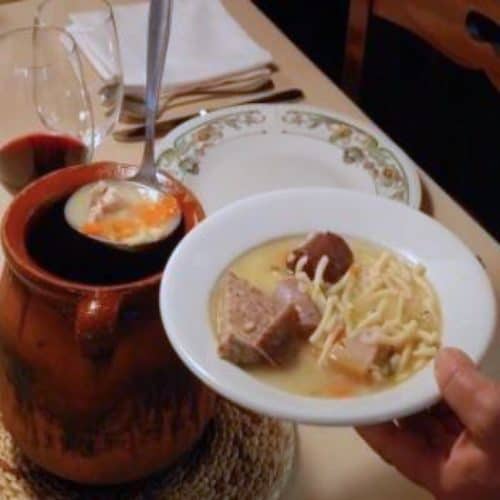
Allioli de codony
Time to leave the Vall d’Aran behind and continue east. From now on, we’ll be moving slowly through the Pyrenees mountains, a region known for its high-quality meats, hearty dishes, and a special sauce: the allioli de codony.
Allioli is made differently across Catalonia. The one people are most accustomed to is made just with garlic and oil. But in the Pyrenees, there’s a sweetest and better (in our opinion!) variety: allioli de codony. A sweet aroma of quince, together with extra virgin olive oil and garlic.
We warn you it’s addictive! Once they bring toasted bread and allioli the codony on the table, chances are you can’t take your hands off it.
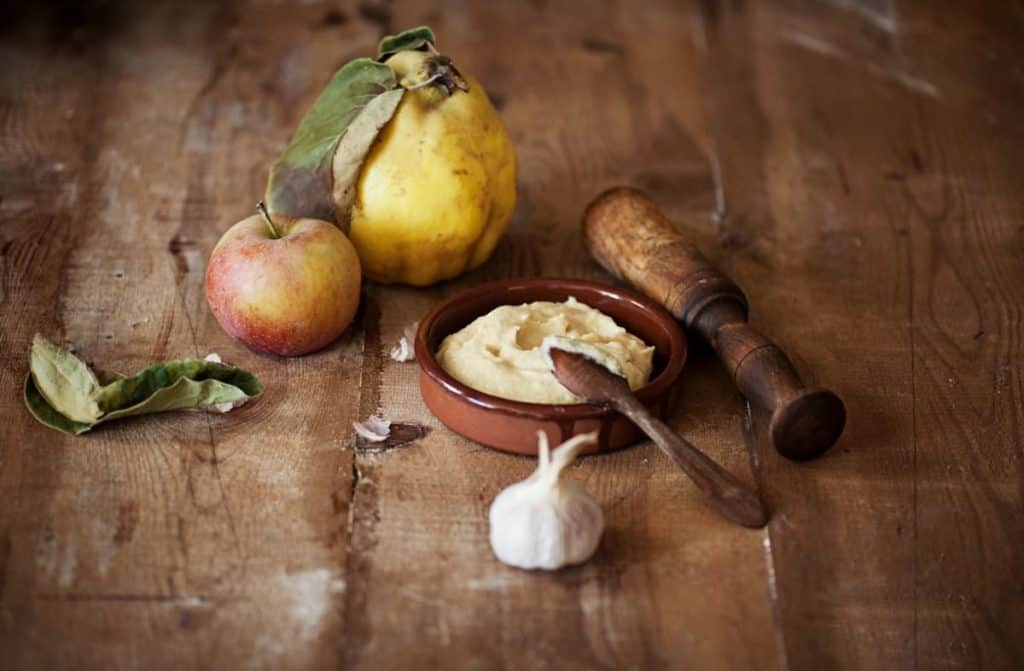
Trinxat
Our next stop is La Cerdanya, a county in the heart of the Pyrenees divided between France and Spain. La Cerdanya’s most iconic dish, and a Catalan classic, is a hearty combination of cabbage and potato known as trinxat, which in Catalan means “mashed” or “chopped”.
It’s a mix of chopped green cabbage and mashed potatoes, resembling the British bubble and squeak. The mixture is fried and then topped with rosta, a thick, crispy bacon slice.
The result? A celebration of mountain flavours perfect for fighting the winter cold and a dish you won’t easily forget!
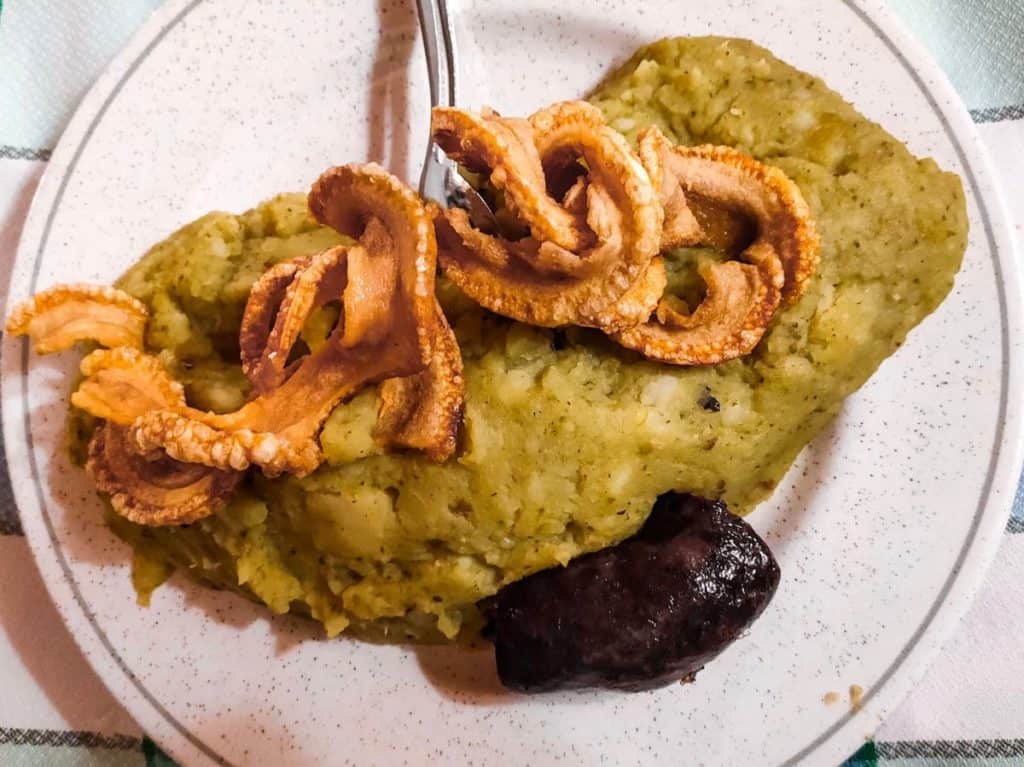
Patates emmascarades
Leaving the high mountain peaks behind, we now descend to the Pyrenees’ foothills, known as the Pre-Pyrenees area. More precisely, we’re going to the county known as El Berguedà.
Here, traditional restaurants serve patates emmascarades and locals love them.
It’s a filling dish that brings together three of the principal ingredients of this region: potatoes, blood sausage, and lardons. While the basic version consists in chopping and frying those three ingredients, in some places, they add mushrooms or cabbage in the mix and crispy bacon on top.
Patates emmascarades translates as masked potatoes because of the darker colour the potatoes get when mixed with blood sausage.
Deliciously simple, you’ll best enjoy them in winter, together with a glass of red wine, a salad, and rustic bread.
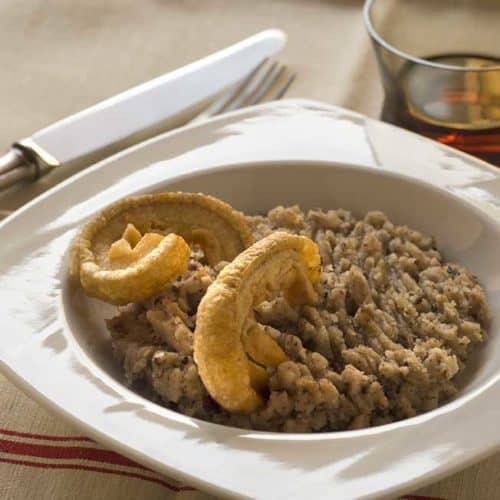
Brandada de bacallà
Brandada de bacallà appeared in the lives of the Pyrenees’ locals when dried cod was introduced to the region.
This dish is traditionally (and laboriously!) made by pounding shredded dried cod in a ceramic mortar and then adding olive oil drop by drop while mixing with the pestle until it creates a thick emulsion with a creamy texture similar to the classic aioli.
In some places, to lower costs, cooks lower the portion of cod and use boiled potato instead. What you should never ever find in a brandada is milk, cream, butter, or any other dairy product. So, if you do, you now know that’s not the real deal!
This delicious dish is usually seasoned with garlic and parsley, and the typical way to eat it is to spread it on toast. Sometimes, it’s also eaten with boiled potatoes. Or as part of a more complete dish, like in the case of pebrots del piquillo, roasted peppers stuffed with brandada de bacallà (mouth-watering!).
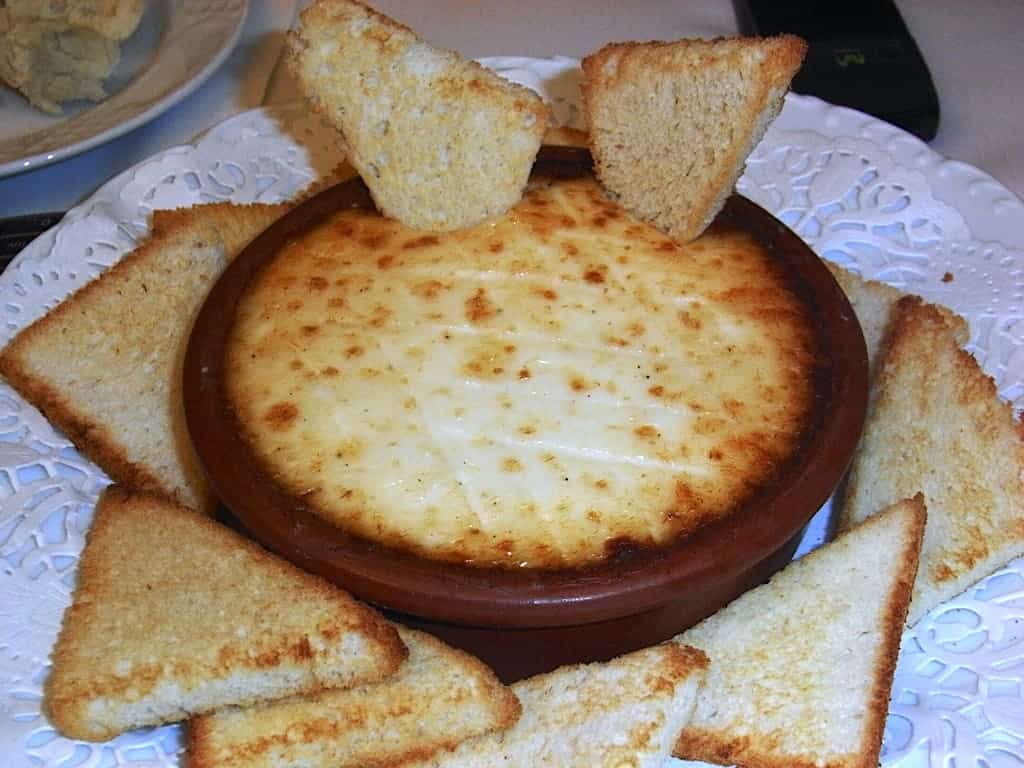
Fricandó
Best described as a beef and mushroom stew, fricandó is usually eaten in autumn, and although it’s not a traditional rural dish (it originated in the city), it’s in the rural areas you can try the real deal.
Each family has its own recipe, but all fricandó dishes share a sweet almond flavour with the meat, mushrooms, and veggies. Chefs usually cook it the day before as it tastes even better after a night resting in the kitchen.
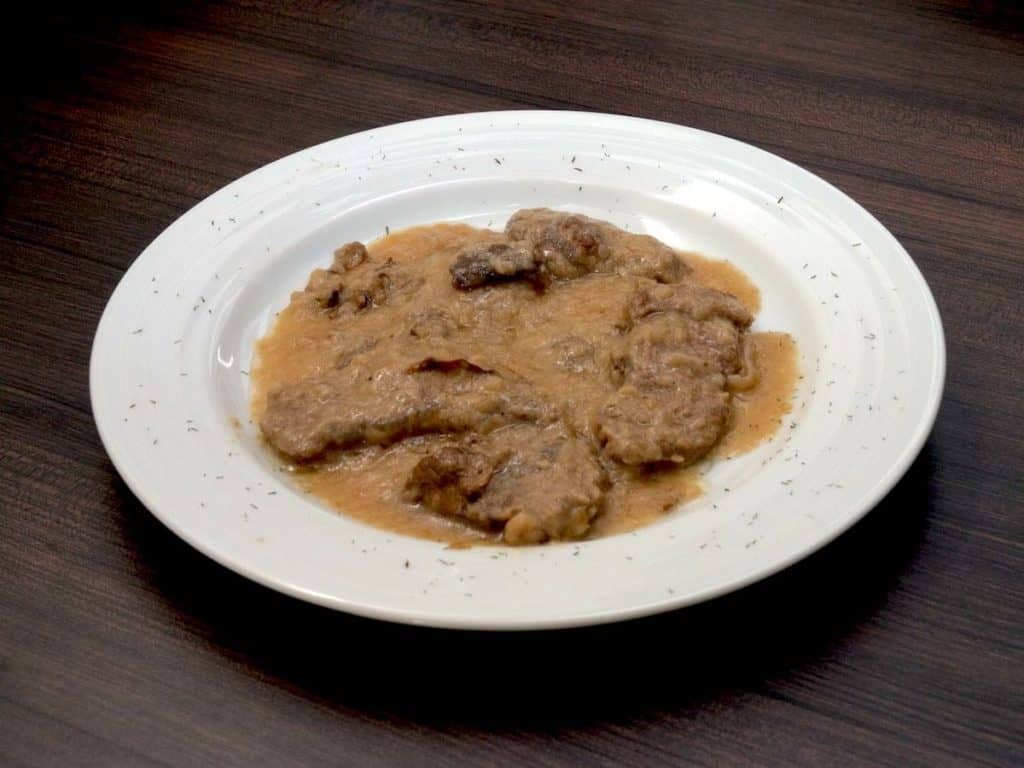
Mandonguilles amb sípia
Time to say goodbye to the rocky peaks and green valleys of the Pyrenees because we’ve reached the easternmost part of Catalonia, where the mountains come down to meet the Mediterranean sea. We find ourselves now in a region we’re sure you’ve heard about: the Costa Brava.
This mix of mountain and sea is translated into the region’s cuisine, which exquisitely combines sea and mountain flavours.
One example are mandonguilles amb sípia. This juicy dish combines all the goodness of meatballs with the tenderness of cuttlefish, cooked in a tomato, fish broth, and wine sauce. Once finished, don’t forget to grab a slice of bread and dip the sauce. It’s one of life’s most delicious pleasures!
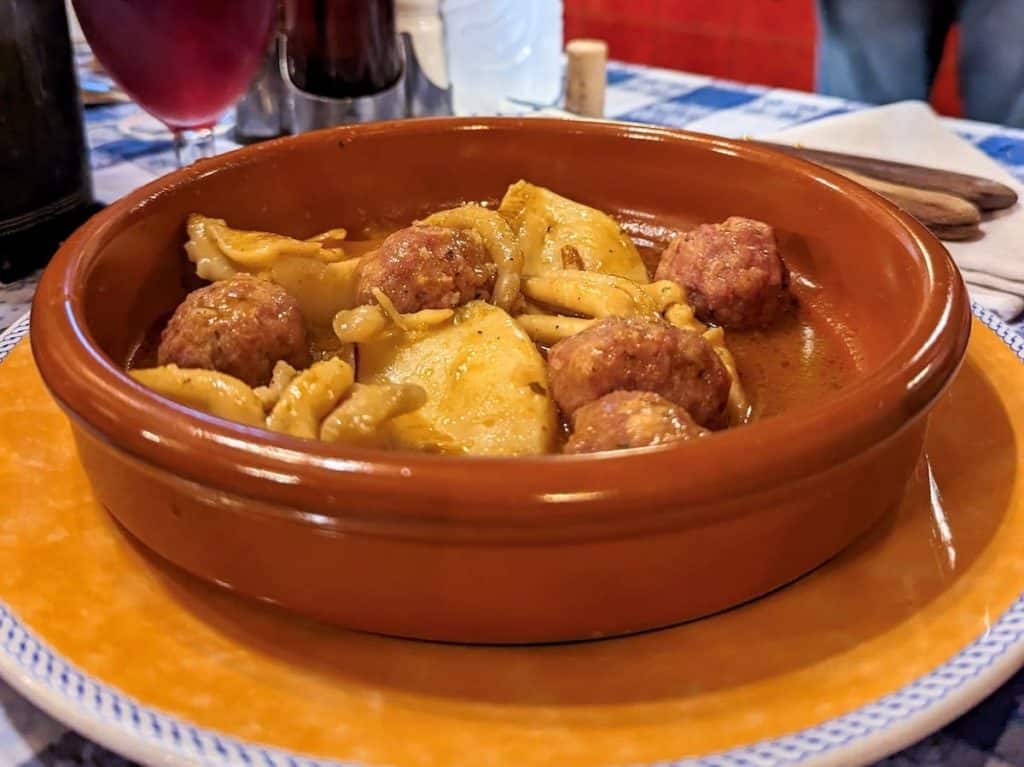
Anxoves de l’Escala
We’re going south along the Costa Brava, and our next stop is the coastal town L’Escala. Why there? Because its anchovy fillets have a reputation for being exquisite!
Anchovies are salted and kept in virgin olive oil, getting an intense flavour with perfect saltiness.
This delicacy, combined with pa amb tomàquet (bread rubbed in tomato), is probably the most uncomplicated yet delicious tapa in the world!
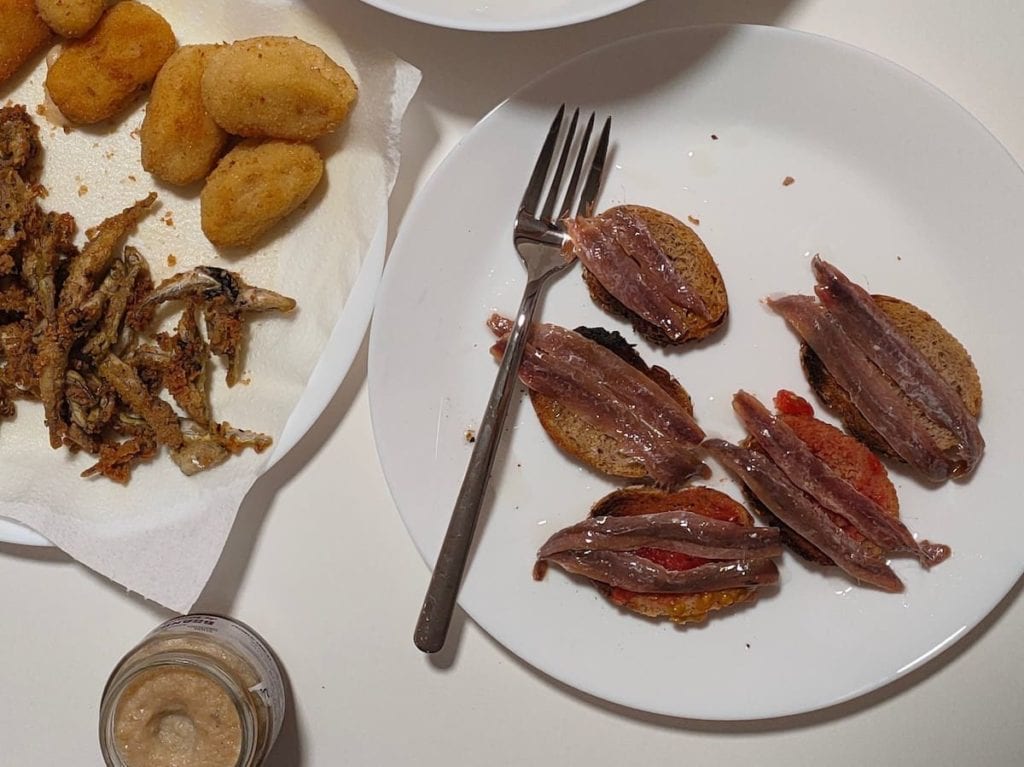
Gambes de Palamós
Geography here in the Costa Brava means seafood is present in most dishes, and it’s certainly not hard to find good fish, shellfish, and seafood in this part of the country. One of the most valued is the Gamba de Palamós.
These prawns are famous for their strong yet succulent flavour. Their colour is intensely red, and they’re renowned worldwide for their tasty meat.
The best way to enjoy them is simply by cooking them on the grill. Nothing else needed.
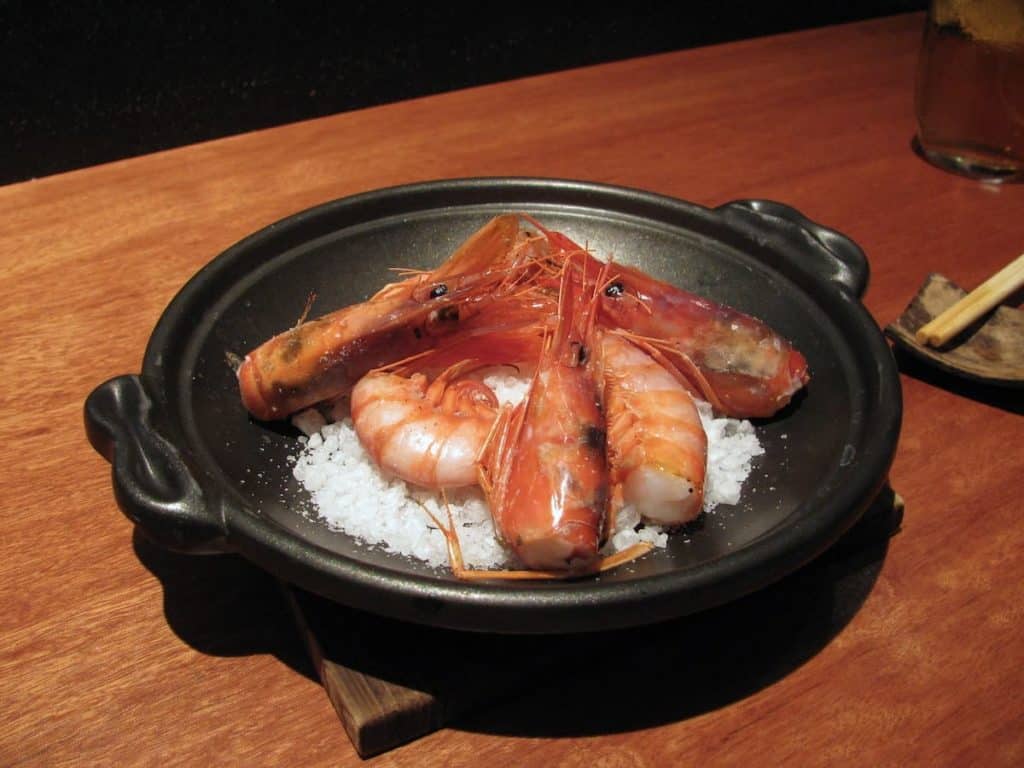
Conill amb bolets
Going inland for a few km, we find ourselves in the beautiful city of Girona. One of the culinary traditions of this city and its surroundings is the conill amb bolets.
A delectable combination of rabbit meat and mushrooms stewed together in a tasty meat broth, tomato and onion sauce, conill amb bolets is a classic of traditional Catalan cuisine. Nowadays, this dish is eaten especially in mountain villages and during the mushroom season.
Depending on which country you’re from, eating rabbits might sound weird. But here in Catalonia, rabbits have been part of our diet for years, traditionally eaten during All Saints’ Day by farmers from the rural areas in Girona’s region.
Esqueixada
Back on the coast, still in the Costa Brava, it’s time to talk about a dish perfect for the hot summer days. When it’s scorching outside, and you’re hungry, it’s the ideal time to order a refreshing esqueixada.
It’s a popular salad made with salted cod, tomatoes, onion, olives, and olive oil. This dish’s name comes from the Catalan verb esqueixar, which means to shred, because of the hand-torn pieces of cod.
The key to this simple dish relies on its ingredients: top-quality cod; mild green onions; Montserrat or cor de bou tomatoes ripened on the vine; good olives; and good extra virgin olive oil. As good as it sounds!
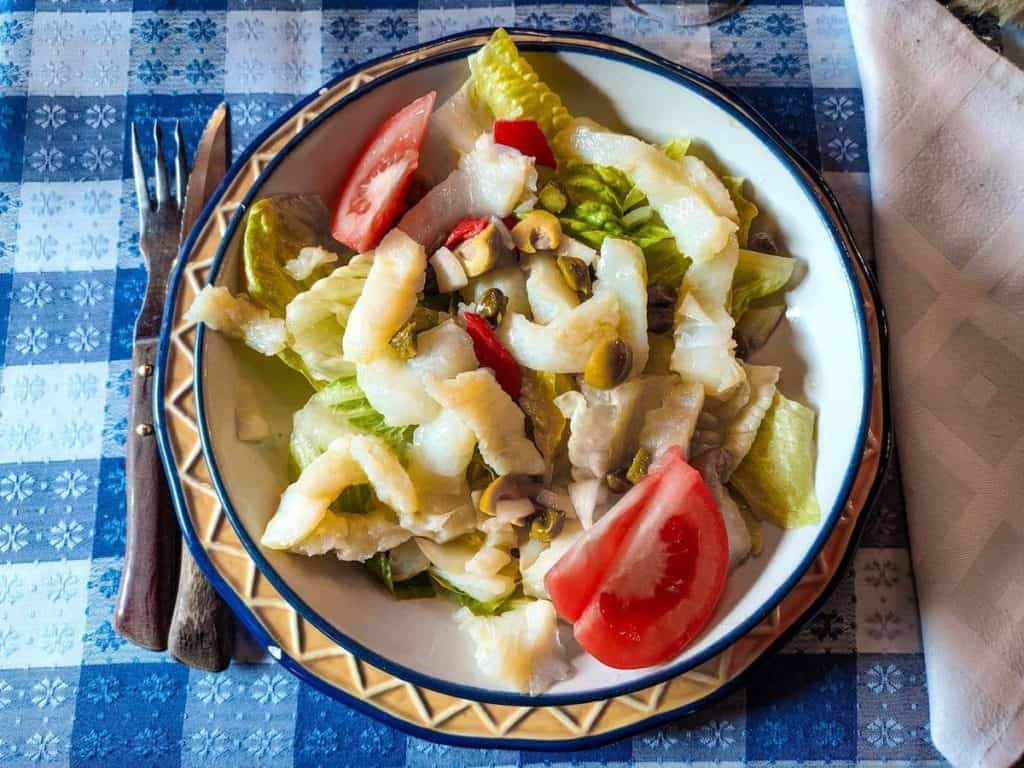
Fideuà
It would be a crime to leave Catalonia without having feasted on a fideuà, the twin of paella, but instead of rice, made with pasta. Here, fideus (a thinner and shorter version of spaghetti) are laden with slow-cooked fish and tomato sauce and fresh seafood. It’s like nowhere else in the world!
Although fideuà is traditional from València, another region in Spain, we have adopted this dish and nowadays can’t think about a summer where fideuà is not on it!
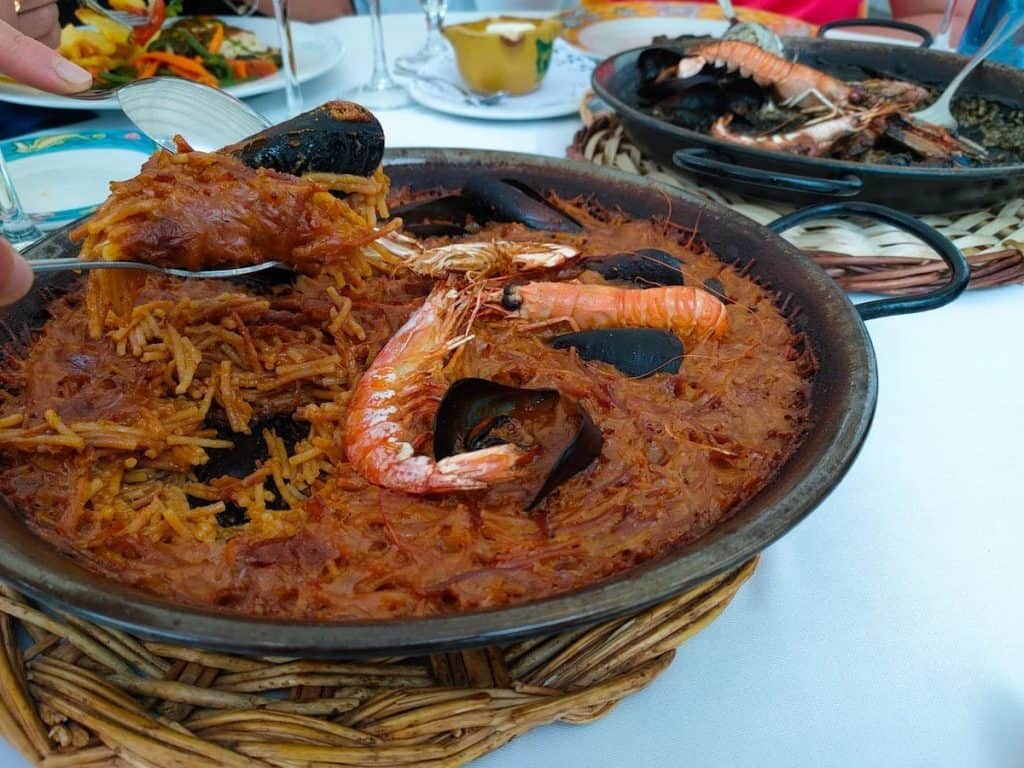
Canelons
After heading south for a while, we’ve arrived in Barcelona. As you might imagine, the Catalan capital is nowadays a foodies’ hub with internationally-known restaurants that feature cuisines from all over the world. But instead of talking about today, let’s travel back in time and talk about our beloved canelons.
Although originally from Italy, Catalans have stolen this recipe, twisted it and made it a symbol of our gastronomy. Few Catalan families would ever consider celebrating Boxing Day without a tray of canelons, traditionally prepared with the leftovers from the meat eaten at Christmas.
Italian chefs who worked for the bourgeoisie in Barcelona in the 19th century imported this dish here. And thank God they did! The recipe rapidly became popular and adapted to the ingredients here, becoming somewhat different from the Italian version.
Here in Catalonia, canelons are made with cylindrical pasta filled with braised and ground pork, beef, and chicken and covered with bechamel and grated cheese. This is the classical version, but today, you can find them filled with meat, vegetables, seafood, mushrooms, etc. It’s a tough decision, but whichever you try, it’ll probably be delicious!
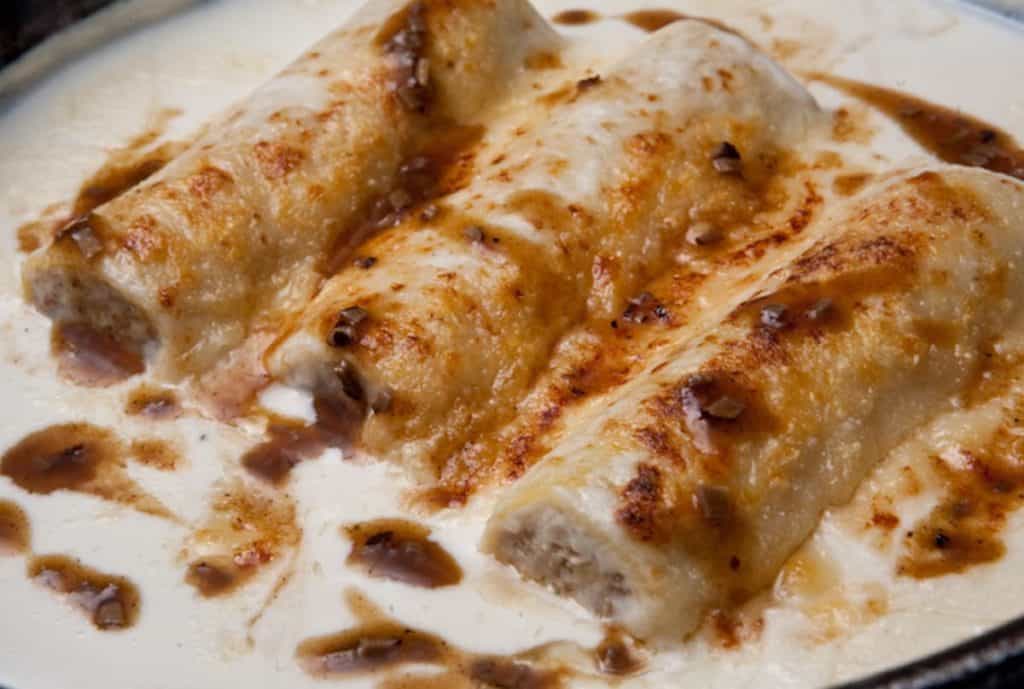
Botifarra amb seques (o mongetes)
Don’t leave Catalonia without eating botifarra amb mongetes, which many Catalans consider their national dish. This pairing of white beans and sausage started in the 19th century in taverns all over Catalonia, but especially in Barcelona.
Nowadays, you can find this simple dish in most traditional restaurants. We sometimes even eat it for breakfast when we’re in the mood for an esmorzar de forquilla (a hearty breakfast in a restaurant, aka the breakfast of champions!).
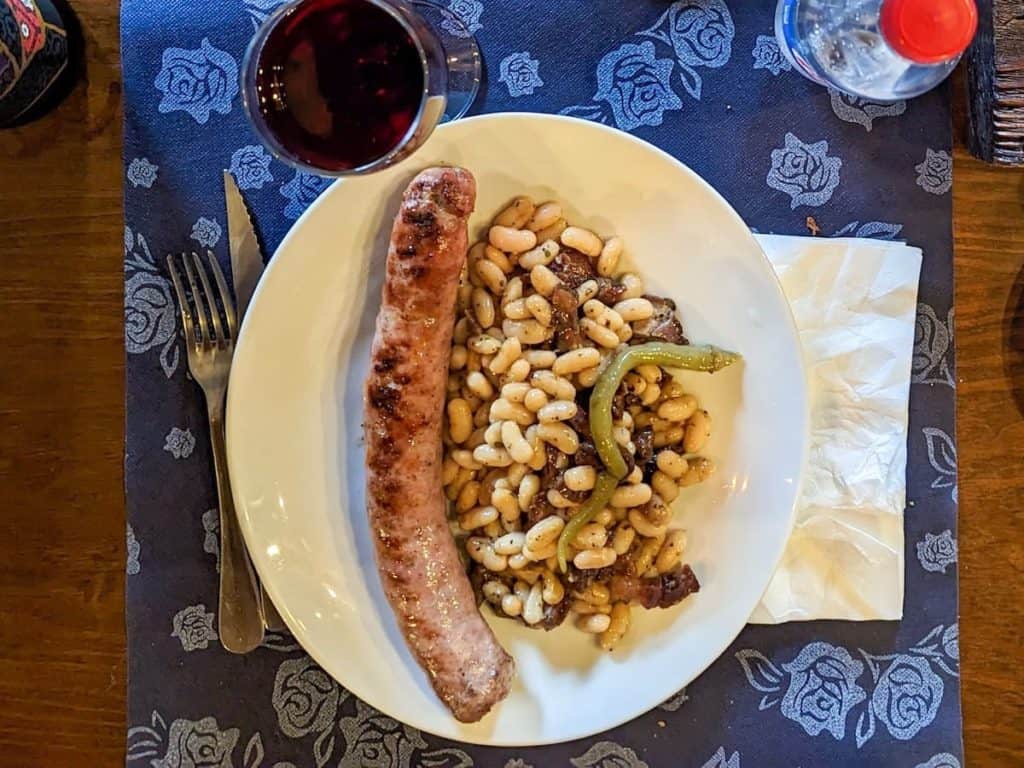
Crema catalana
The classic creamy custard covered with a thin crust of burnt sugar is the perfect pick-me-up and probably the world’s most widely enjoyed Catalan dessert.
Imagine yourself breaking through the burnt sugar crust with a spoon and grabbing a piece together with the lemony and cinnamony custard under. There may be no more perfect way to end a meal than this excellent combination of sweetness and crispiness!
Crema catalana might remind you of crème brûlée. Still, while the second one is thickened with whole eggs and cream, the Catalan version uses milk, egg yolks, and starch.
Local legend credits this dessert to a mistake that convent nuns made when preparing a flan for a visiting bishop. The flan failed, and in an attempt to save it, the nuns added some burnt sugar on top of the liquid mess. When the bishop took a bite, he shouted “Crema!” which in Catalan means “It’s burning hot!”.
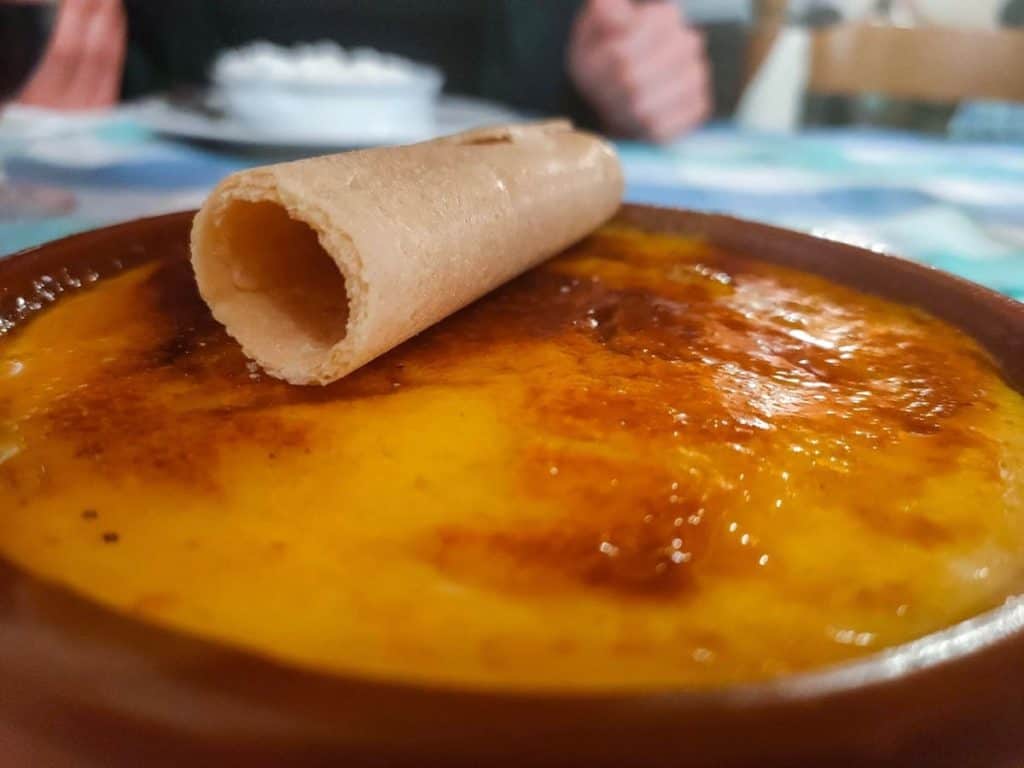
Carquinyolis
The locals from Barcelona’s surroundings sure know their way around a sweet! They mix almonds with eggs, sugar, and flour and put it in the oven until they get a dry, crispy biscuit called carquinyoli, similar to Italian cantuccini. Found across the region, the most famous are the ones made in two villages named Cardadeu and Caldes de Montbui.
The sweet almonds give this dessert its particular nutty flavour, and it’s hard to stop at one!
Although the traditional recipe contain almonds, you can also find other versions made with different nuts, chocolate, or cranberries.
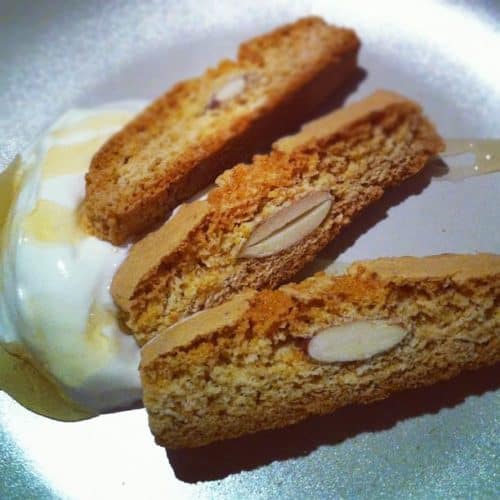
Arròs negre
Anything involving rice and seafood is bound to be of exceptional quality in the province of Tarragona (south of Barcelona), and this is the case for arròs negre. This rice dish is one of Catalonia’s best coastal foods, and it’s easy to recognise because of its characteristic black colour.
After spending rough workdays in the sea, fishermen eke out every last bit of worth from their catch. Nothing gets to waste, not even the ink from a cuttlefish or a squid. And this is actually the key ingredient that takes paella to a whole new level.
Arròs negre is similar to paella, but instead of cooking the rice with broth and tomato, the rice is cooked with squid or cuttlefish ink and served with mussels, cuttlefish, squid, prawns, or other seafood.
Oh! And the best part is to mix it with a little bit of the allioli served on the side, which perfectly balances the natural sweetness of the ink.
Arròs de cranc blau
We find ourselves in the southernmost part of Catalonia, in the Delta de l’Ebre, where the Ebre river meets the Mediterranean sea. Here, locals are pretty fond of their rice and have hundreds of ways to cook it.
Arròs de cranc blau is the most famous one for the past years. It consists in slow-cooked rice served with another regional speciality, cranc blau (blue crab).
It’s a foreign specie that reached the Catalan coasts some years ago and hasn’t stopped growing in numbers since then. In an attempt to stop this plague, the blue crab has been introduced into the local’s cuisine, creating this mellow and tasty rice dish.
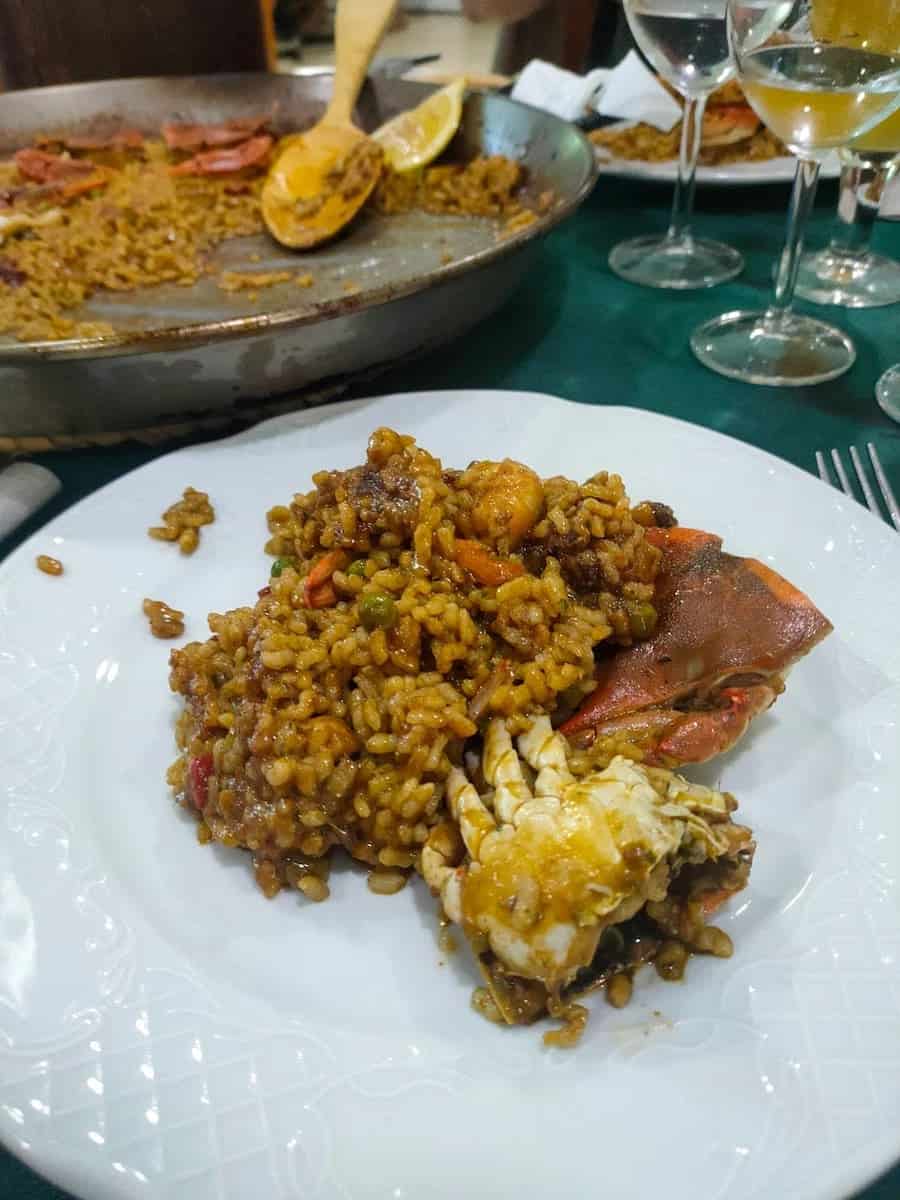
Calçots
It’s time to leave the coast behind and move inland to a town named Valls. Here is where calçots, one of the foods we love the most, is original from.
Picture this: a kind of spring onion, much thicker and with a longer white part. This is a calçot, Catalonia’s favourite winter veggie. But as much as we like calçots, what we truly enjoy is the sauce we eat them with. This nutty sauce, called romesco, is made with tomatoes, roasted red peppers, toasted almonds, vinegar, and garlic. Calçots alone aren’t that spectacular, but as soon as we dip them in romesco sauce, it takes them to a whole new level!
Especially in February and March, one of the favourite hobbies of the Catalan people is to enjoy a calçotada, a winter BBQ centred around eating calçots. Calçotades start by making a hot fire and grilling the calçots to perfection over it. Once they are slightly black, it’s time. to wrap the calçots in newspaper to keep them warm, just like Fish & Chips.
Important! When eating calçots, never ever use a fork or a knife to peel off the charred outer layer. That’s the most essential rule: Calçots are ALWAYS peeled with bare hands! Once peeled, deep them in the romesco sauce and eat them. Sweet, tender and absolutely delicious!
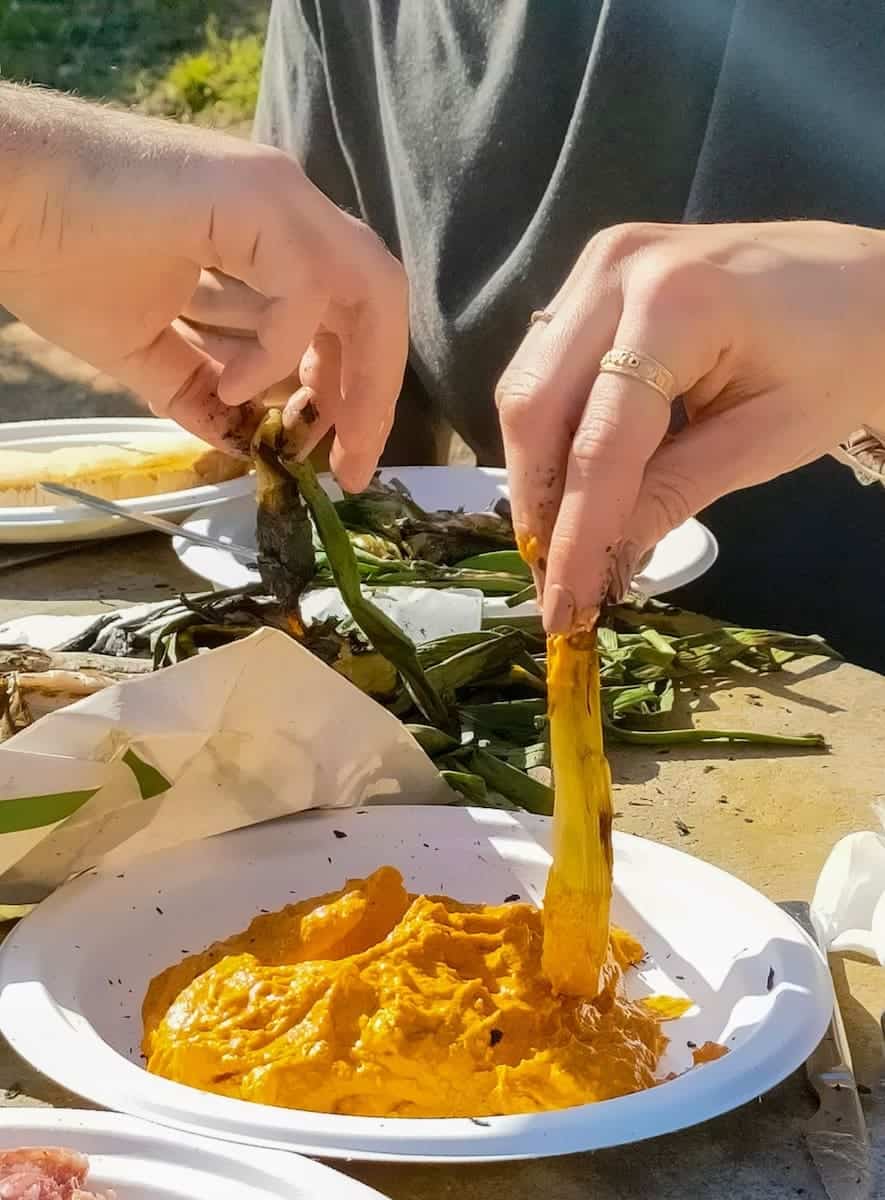
Mel i mató
Going a bit north, we stop at the heart of Catalonia, where there is a famous mountain massif with quirky-shaped peaks and a monastery visited by thousands of travellers: Montserrat.
But Montserrat is not only famous for its shape or for being a religious site. It’s also renowned because mató has been produced and sold in the area for years, and without mató, one of the simplest (yet most mouthwatering!) Catalan desserts wouldn’t exist. What are we talking about?
Fresh cheese. Nuts. Honey. That’s probably all you need to know! Mel i mató is a traditional sweet made with mató, a textured cow or goat’s cheese, drizzled with local honey (mel in Catalan) and garnished with nuts. It’s the perfect marriage of crispy, milky and sweet.
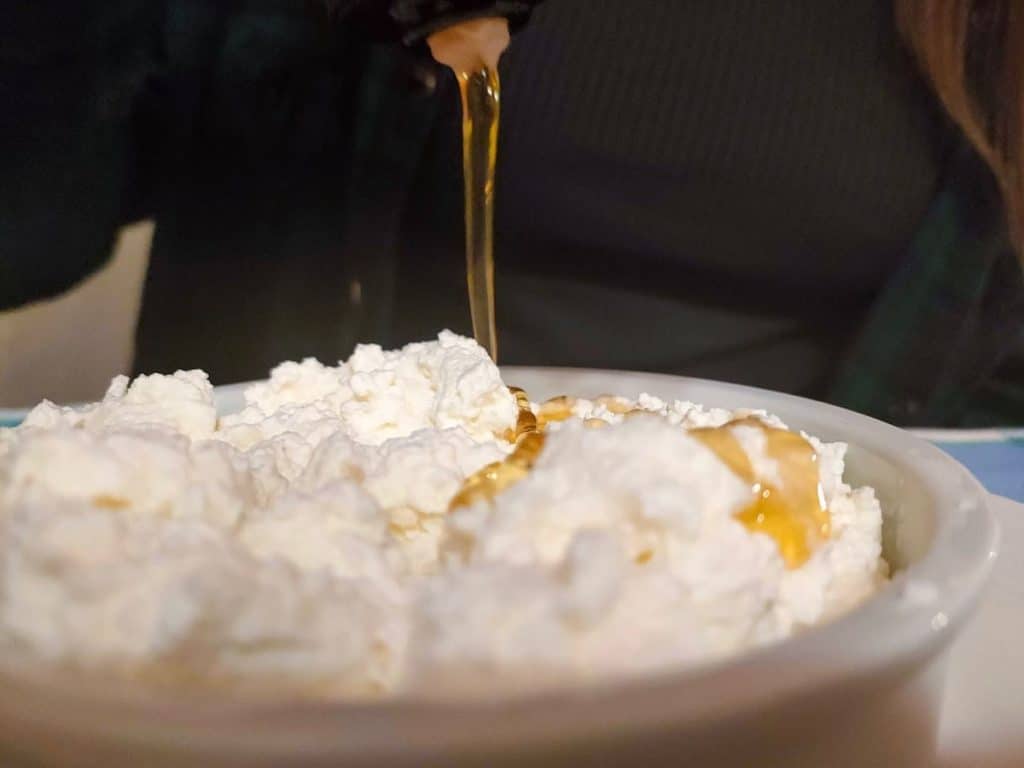
Espinacs a la Catalana
One of Catalonia’s finest examples of how we like to mix sweet and savoury, this traditional dish brings sauteed spinach, toasted pine nuts, and plump raisins together. As simple, and believe us delicious, as it sounds.
This dish can be eaten as a starter, but it can also be used as a filling for canelons or an omelette.
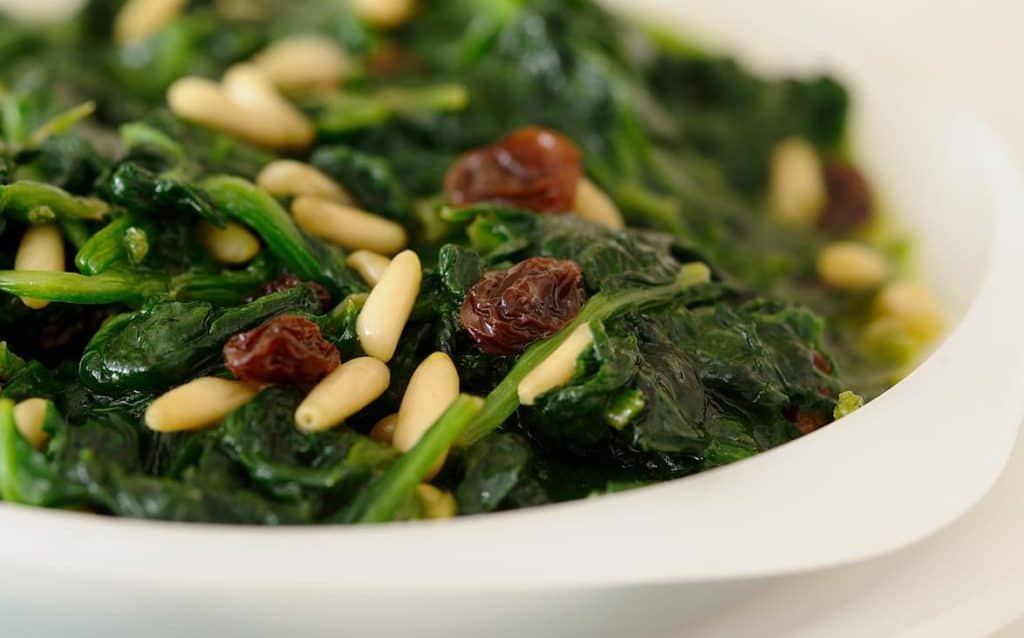
Pa amb tomàquet
Pa amb tomàquet had to obviously be on this list too! We can’t get enough of the toasted rustic bread rubbed with tomato and drizzled with a generous splash of olive oil.
Try it with cured meats, cheese, and truita de patates (Spanish tortilla) for breakfast and as a snack, or alongside grilled meats, calçots, or sardines on the barbecue for an authentic taste of Catalan food.
Oh! And you’ll also find it served in traditional Catalan restaurants – that’s how you know it’s authentic!
Pa amb tomàquet is one of those beloved simple, ubiquitous, and practical dishes – it likely began as a way to moisture and rescue old dry bread in the farmers’ houses.
We love it so much that we even cultivate a special tomato variety just for this! It’s called tomàquets de penjar, and they’re small red pieces of heaven packed with flavour!
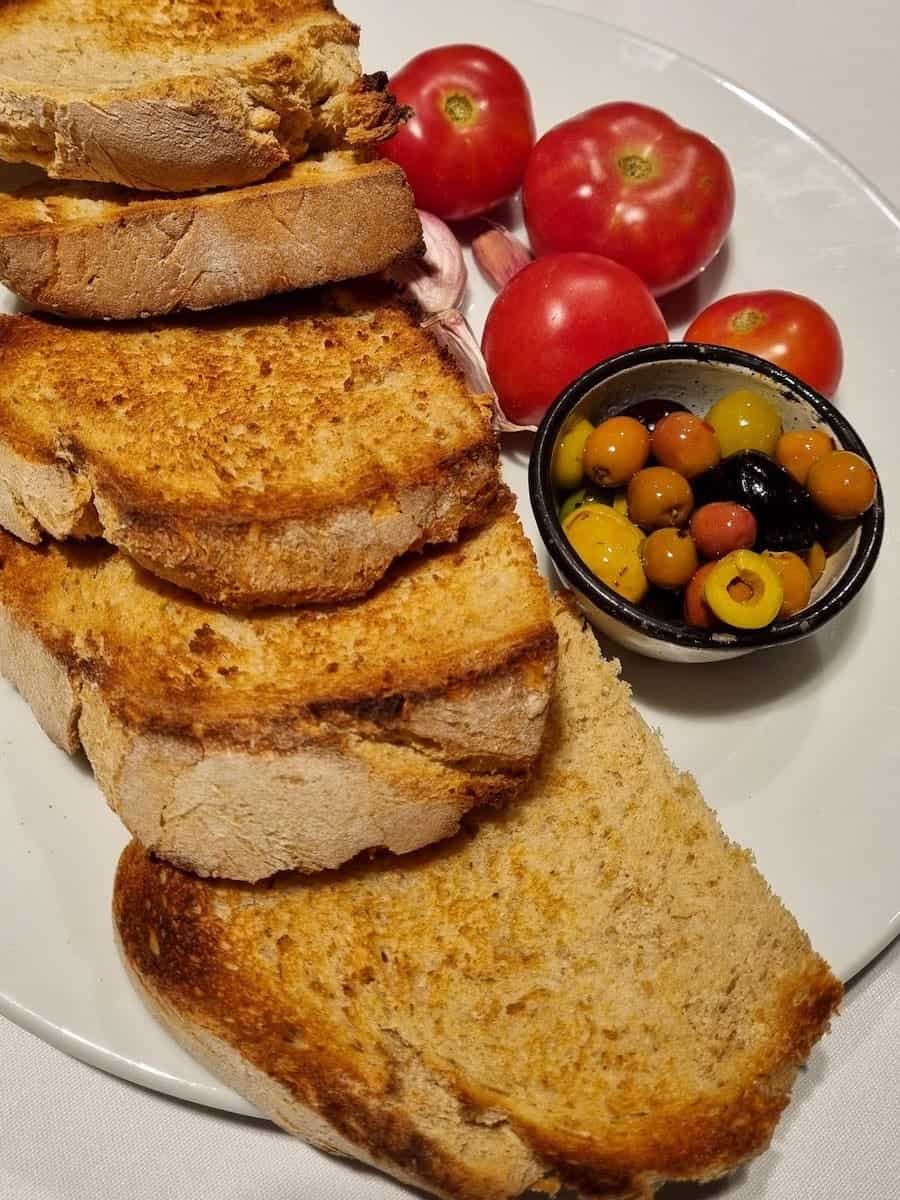
Fuet
Especially around the medieval city of Vic, the area has a long history of embotit (cured meats) making. It’s where the fuet comes from, a long and thin cured sausage made with pork meat and seasoned with salt and spices.
Try it alone as a snack (who hasn’t gone to the kitchen, seen the fuet hanging and cut a couple of slices?) or together with pa amb tomàquet. Sandwiches of fuet are part of many Catalan’s childhood, and sliced fuet is always present in weekend appetizers, BBQ, or calçotades. Careful cause once you start you can’t stop!
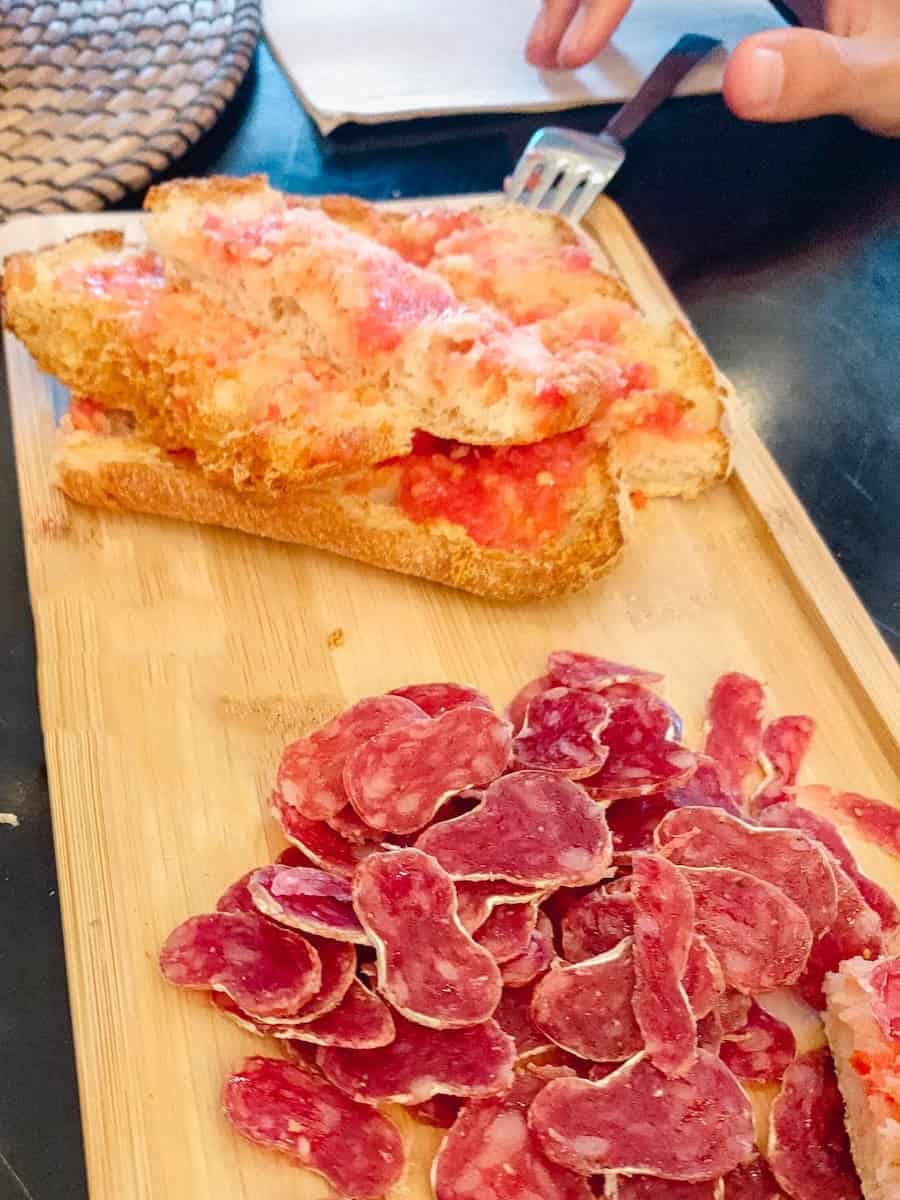
Cargols a la llauna
We’re about to finish our trip, and for those two last dishes, we’ll be travelling west to Western Catalonia, also known as Terres de Lleida. Snails hold an important place in this region’s cuisine, and there are more than a dozen traditional ways to cook them. But the simplest and most well-known is cargols a la llauna.
Snails are placed on a baking tray with their openings facing upward, drizzled with virgin olive oil, flavoured with salt and pepper, given a pinch of finely chopped parsley and garlic, and cooked in their own juices.
In case you’re unfamiliar with eating snails, hold the shell with your hand and get the meat out with the snail fork. Be sure to generously dollop with aioli!
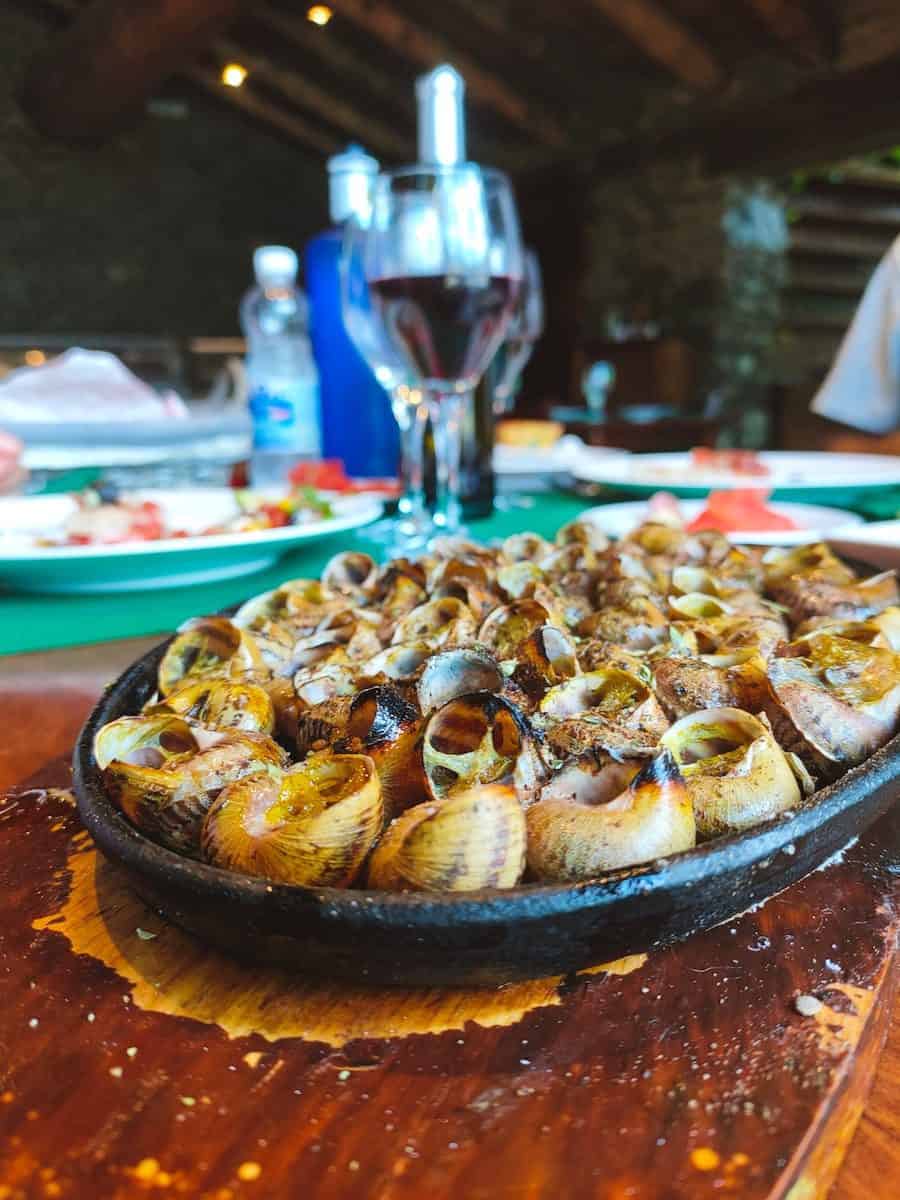
Coca de recapte
At first glance, you could mistake the coca de recapte for a pizza. The concept is similar: a dough baked in the oven with veggies, meat, and sometimes fish on top. But the coca de recapte has its own peculiarities. What you put on top is always escalivada (slices of roasted red pepper and eggplant with a smokey flavour) and sausage or herring.
Try this salty speciality in bakeries around the country, especially in Western Catalonia.
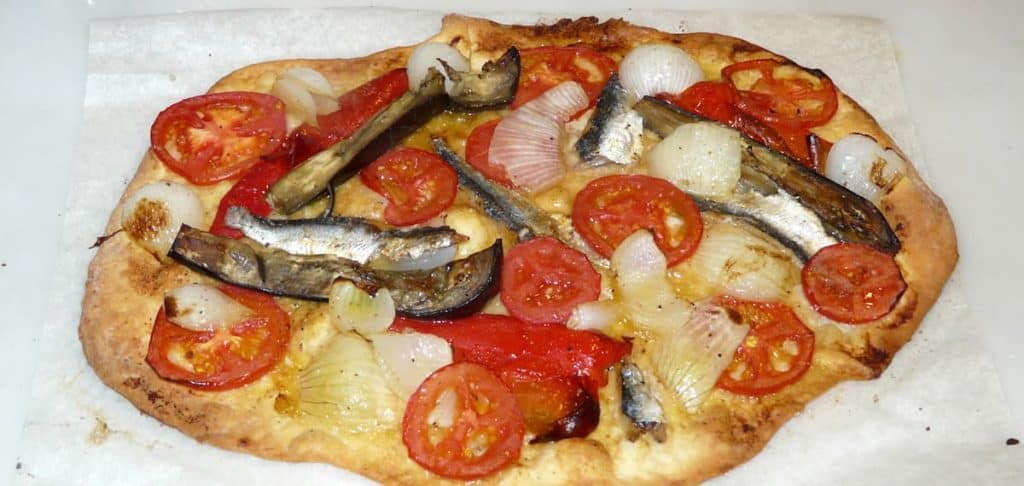
Our mouth-watering adventure ends here. Now, it’s your turn to take a trip to this beautiful region and satisfy your cravings! With so many tasty dishes to try, you’ll be planning your return trip before you’ve even left the table!

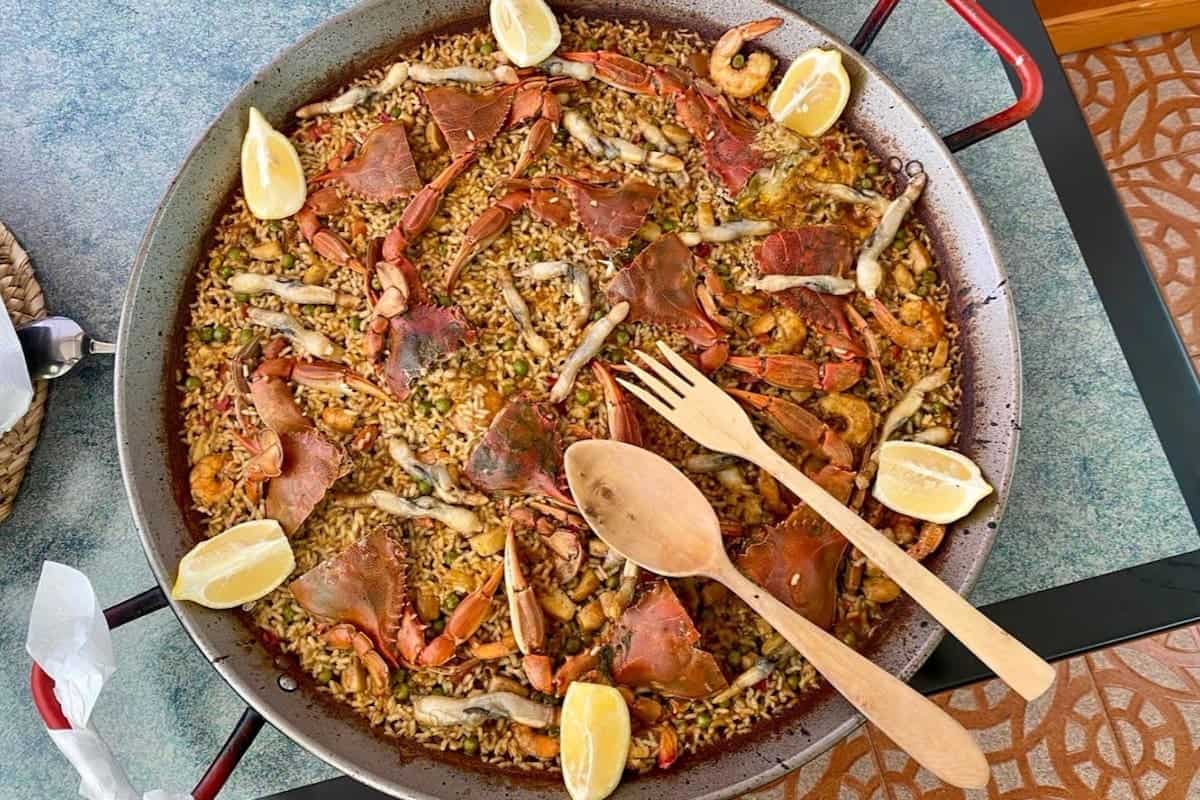
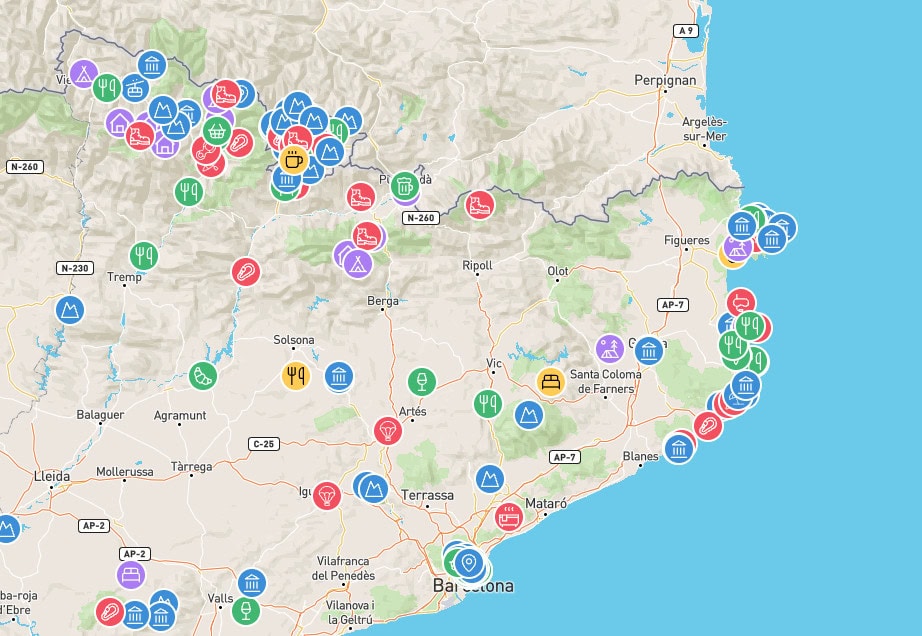
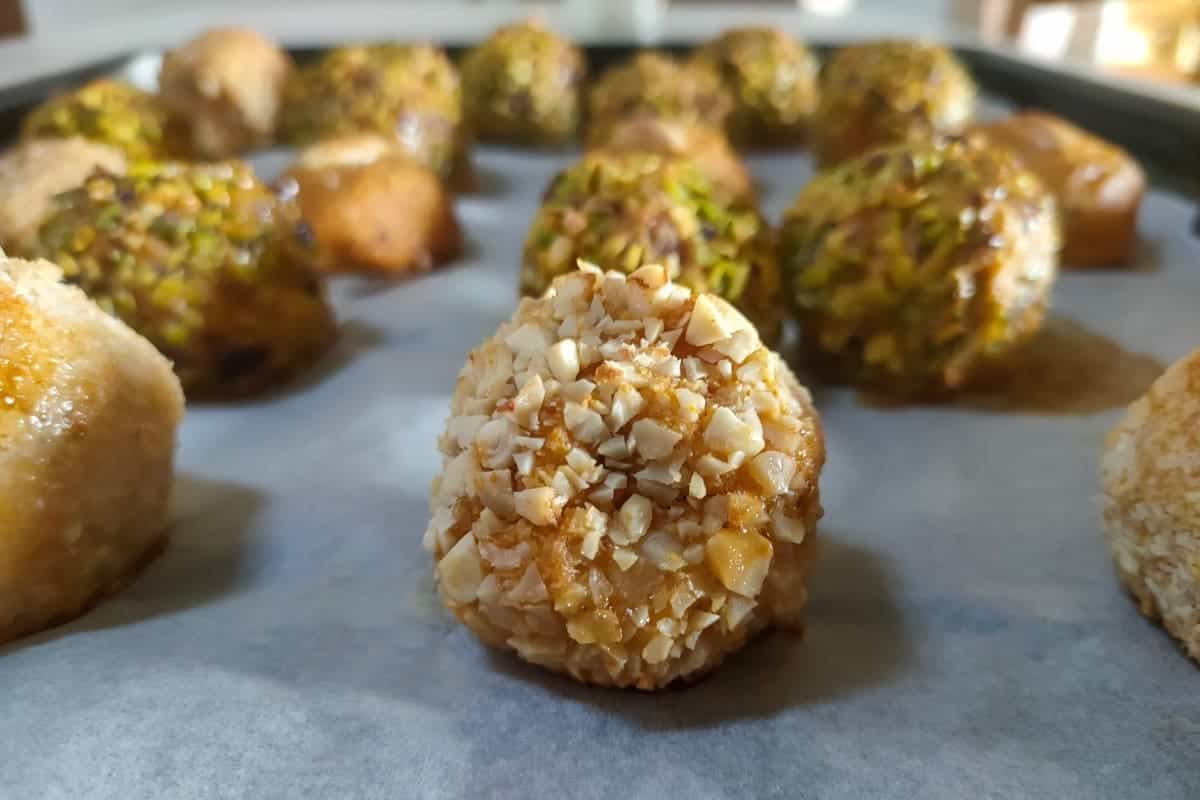

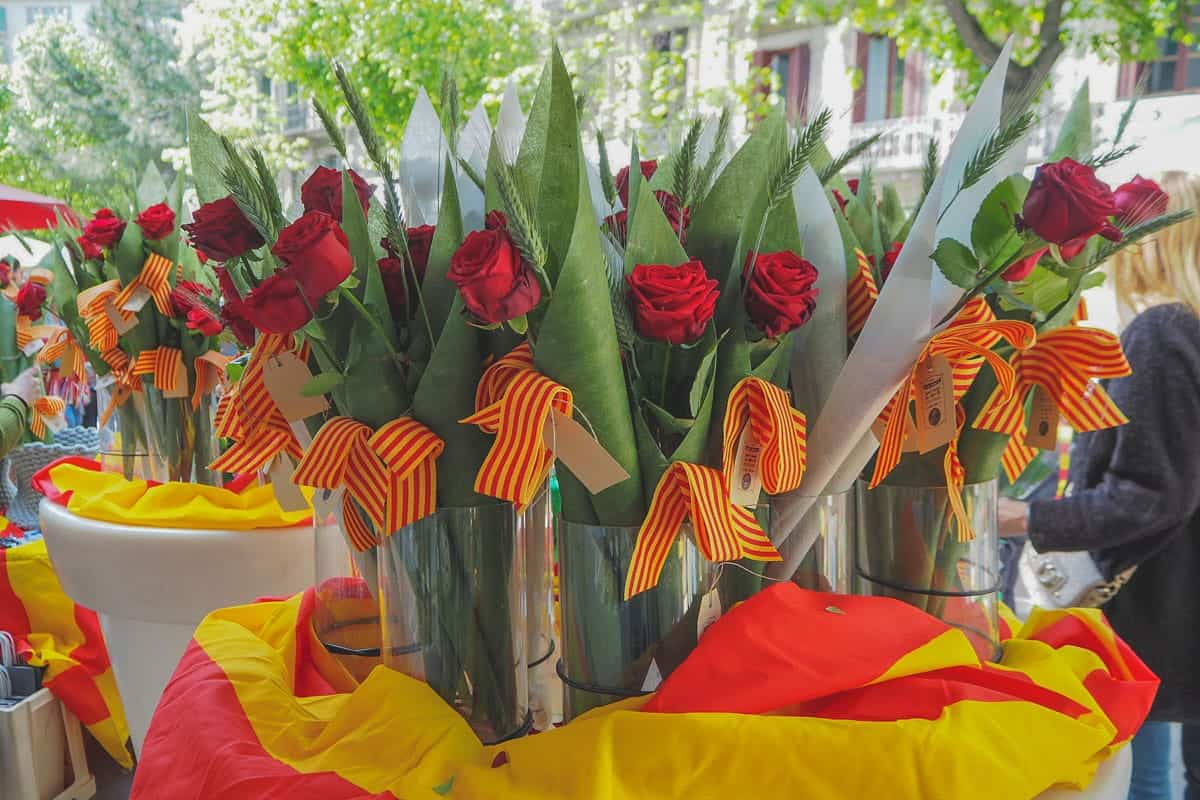
0 Comments